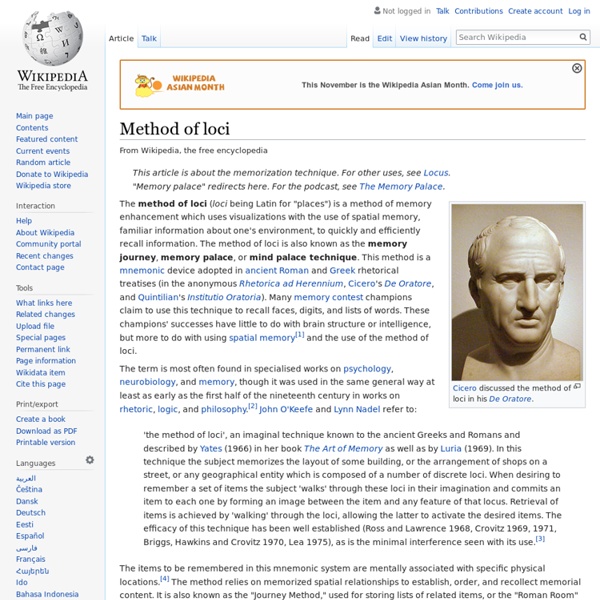Ideasthesia
Idea in psychology Example of associations between graphemes and colors that are described more accurately as ideasthesia than as synesthesia Ideasthesia (alternative spelling ideaesthesia) is a neuroscientific phenomenon in which activations of concepts (inducers) evoke perception-like sensory experiences (concurrents). The name comes from the Ancient Greek ἰδέα (idéa) and αἴσθησις (aísthēsis), meaning "sensing concepts" or "sensing ideas". The notion was introduced by neuroscientist Danko Nikolić as an alternative explanation for a set of phenomena traditionally covered by synesthesia.[1]
Pomodoro Technique
Time management method A Pomodoro kitchen timer, after which the method is named. The Pomodoro Technique is a time management method developed by Francesco Cirillo in the late 1980s.[1] The technique uses a timer to break down work into intervals, traditionally 25 minutes in length, separated by short breaks. Each interval is known as a pomodoro, from the Italian word for 'tomato', after the tomato-shaped kitchen timer that Cirillo used as a university student.[2][3]
How to Build a Memory Palace: 11 steps
Edit Article Sample Memory PalaceCreating Your Own Memory Palace Edited by Waited, Ben Rubenstein, Ruslan M, Jack Herrick and 33 others One of the most useful and widely used mnemonics (or memory aids) is the memory palace, a place or series of places in your mind where you can store information that you need to remember. With time and practice, anyone can build a memory palace, and they are useful for far more than just memory competitions and trivia. Ad
Clavier à lumières
The clavier à lumières ("keyboard with lights"), or tastiera per luce, as it appears in the score, was a musical instrument invented by Alexander Scriabin for use in his work Prometheus: Poem of Fire. However, only one version of this instrument was constructed, for the performance of Prometheus: Poem of Fire in New York City in 1915.[1] The instrument was supposed to be a keyboard, with notes corresponding to colors as given by Scriabin's synesthetic system, specified in the score,[2] However, numerous synesthesia researchers have cast doubt on the claim that Scriabin was a synesthete.[3][4][5][6] The "Luce" part is notated on a treble staff with two parts, one proceeding on the circle of fifths during the piece, the other following the tonal centre of the music.[clarification needed] Scriabin assigned the following colors to the following key areas:[citation needed]
Spirituality
“Success is a journey, not a destination.” Ben Sweetland Phew it’s been a while … :) I quit the job at my own company now and looked to start something new and make sense of how the personal and spiritual growth fits together. One nagging issue I had was the seemingly conflict between the drive to success and spiritual being – I posted about it several times, not only on this blog … and I want to give some insights about this topic that I realized over the last view weeks: A New View on Success It is much easier for me now to have fun creating again and strive for and enjoy success.
What is MITx?
This set of FAQs accompanies MIT’s Dec. 19, 2011 announcement regarding MITx. Why is MIT doing this?MIT seeks through the development of MITx to improve education both on the MIT campus and around the world.
Solomon Shereshevsky
Solomon Veniaminovich Shereshevsky (Russian: Соломон Вениаминович Шерешевский; 1886 – 1 May 1958), also known simply as 'Ш' ('Sh'), 'S.', or Luria's S was a Russian journalist and mnemonist active in the 1920s. He was the subject of Alexander Luria's The Mind of a Mnemonist (1968). Studies[edit] Shereshevsky participated in many behavioral studies, most of them carried out by the neuropsychologist Alexander Luria over a thirty-year time span.
Maintaining a laboratory notebook » Colin Purrington
Some gratuitous advice on why and how to keep a written log detailing your science. Why you might want to keep a laboratory notebook To provide yourself with a complete record of why experiments were initiated and how they were performed. You’ll forget if you don’t. Yes, you — even in your youth your brain cells are senescing, and the details will fade.To give yourself a central and physical place to record your data, to note statistical outcomes, and to paste graphs that show off your amazing results or dismal failures (the latter building character, hopefully).



